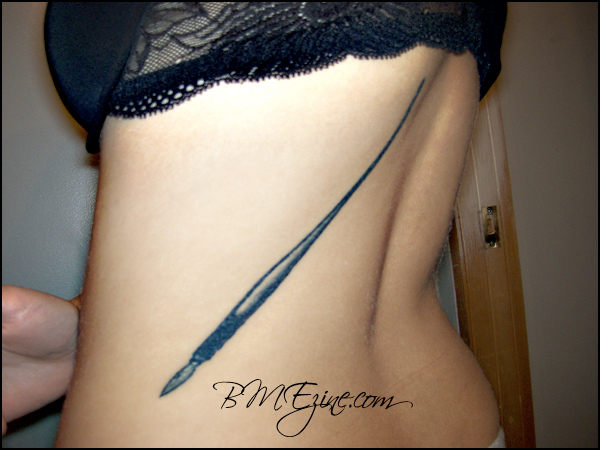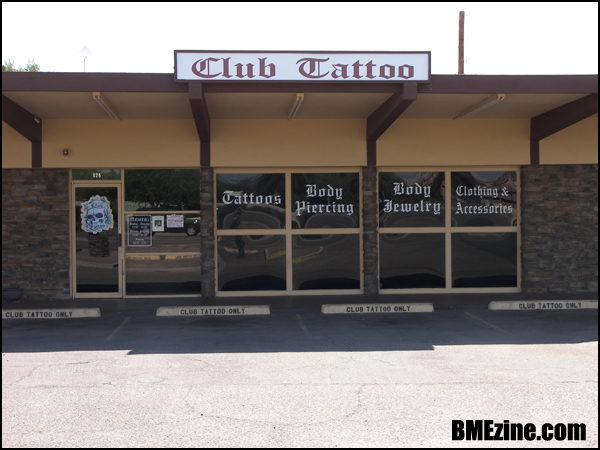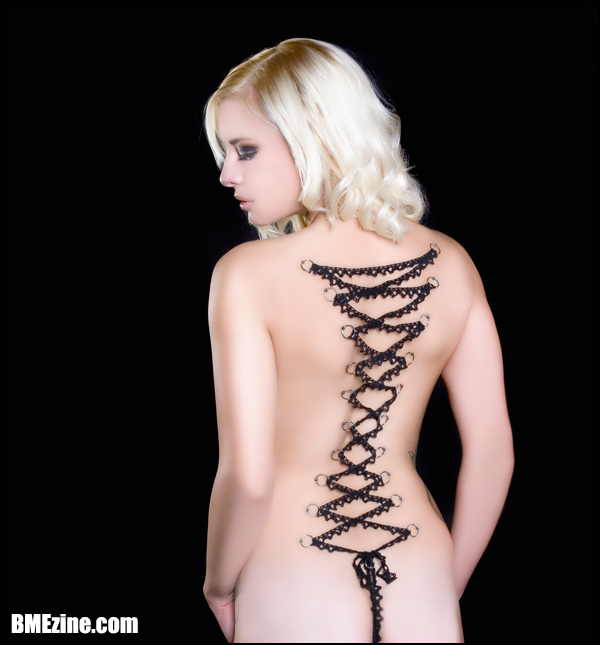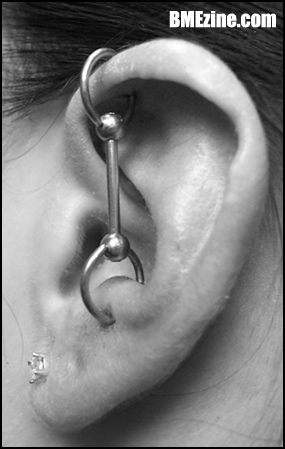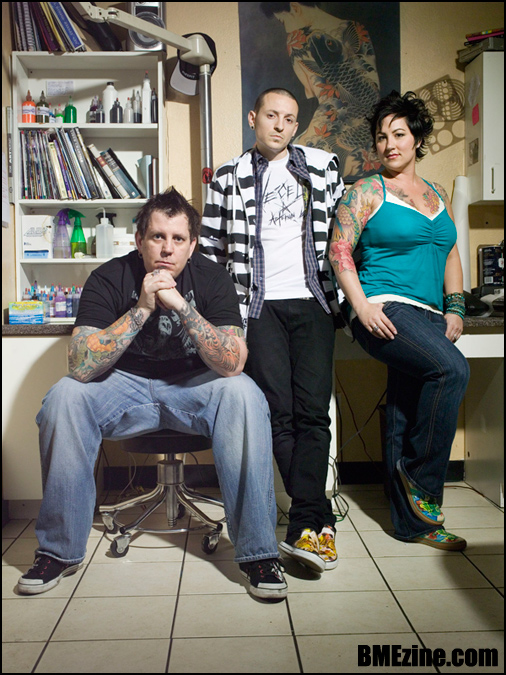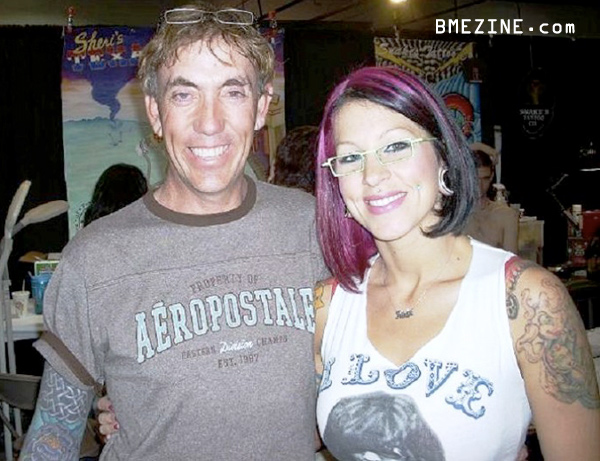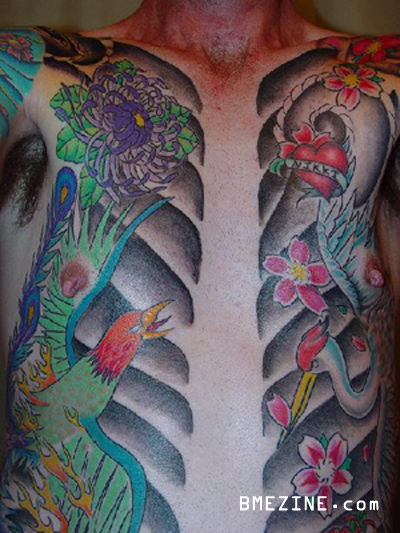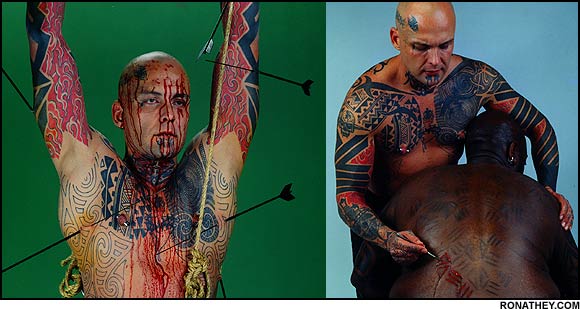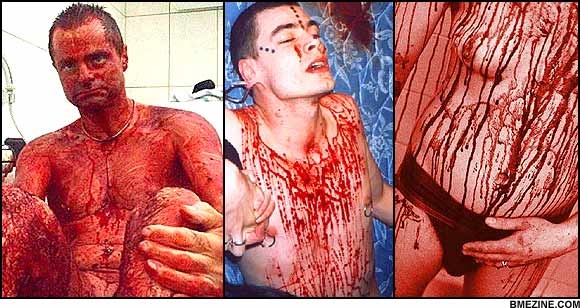From January 18-20, 2009, Milan, Italy, played host to the Italian Professionals Piercers and Tattooists Association conference, of which BME was a sponsor. Rachel was there, and brought along a friend: Adam from BodyMod.org. This is Adam’s convention diary.
I was in San Francisco for two weeks attending some software training classes with my business partner when I received an email from Rachel. She informed me that BME was to sponsor an upcoming Tattoo and Piercing Conference in Italy (APTPI), but that she may not be able to attend due to a snowboarding accident; some skier had taken her out from behind and messed up her knee so badly that she couldn’t walk. She asked me if I was able to go instead and provide some coverage for BME. I had been to Europe a few times, and always wanted to check out Milan, so I figured, “What the hell?”
I changed my returning flight from San Francisco to return a day earlier to make it back to New York City to repack and jump on a plane to Milan. I’m a frequent and very spontaneous traveler, so I’m familiar with these types of travel conditions.
A few days leading up to the return to NYC/departure to Italy, Rachel informed me that her leg was feeling much better and that she would be able to go as long as she wore a leg brace. So now it was going to be the two of us heading out there. I welcomed the opportunity to get to know Rachel as a person and not just from all the rumor-mongering. I was hesitant, and kind of on guard, but I went with an open mind.
I arrived at JFK airport about an hour before we were to begin boarding. With my luck, it was a smart move: There was an “issue” with my ticket … awesome. I never found out what the deal was, but I got the pleasure of standing in two separate lines that both terminated with women that seemed pretty irritated that I got in their line. (Side note: I have amazing luck with having to deal with people that just seem to hate me from the get-go in the airline industry. I guess I’m just awesome like that.)
I got my ticket, proceeded through security, and then off to the waiting area where I was to meet up with Rachel. I saw her working away behind a laptop and fidgeting with her stuff. We said our hellos and moved all our bags towards the gate for boarding.
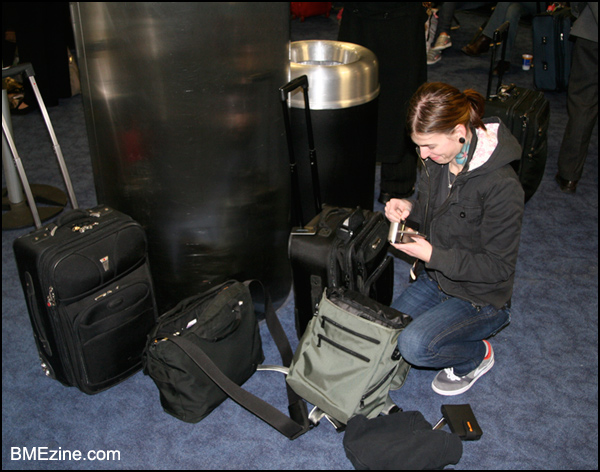
Our rows were called and we got on the plane. Our flight time was six-and-a-half hours. We left at 5:15 p.m. on Saturday and landed at 6:45 a.m. on Sunday (six-hour time difference). We must have had an awesome tailwind, because we shaved an hour off of our flight time. The first thing I noticed when we deplaned was the smell of smoke and a fire alarm going off. Perfect! We never found out what the smoky smell was coming from, but the alarm was turned off by the time we reached customs.
Now normally, I fly right through customs with no problems, and I was expecting the same here. Welp … looks like Rachel doesn’t have that luck. The customs guy picked up the phone and looked kind of pissed off. Great! If he doesn’t like her, he’s just going to love me.
Since neither of us spoke Italian, we’ll never know what he was going on about, but eventually he let her through and then I just sailed right through.
Brenno or Bruno (two of the guys putting on he convention) were supposed to meet us at the airport and give us a ride back to the hotel, but since we were an hour early, nobody was there. Rachel also informed me that they most likely wouldn’t be showing up anyway, because it was seven in the morning and they’re most likely passed out and recovering from last night’s partying. We opted to take a taxi to the hotel and hope to catch them before they left. To anyone that’s taking a trip to Italy, don’t take a taxi!! They’re expensive as hell!
We arrived at the hotel and tried to check in, but my room wasn’t ready yet, and I had to come back at noon. Even better than that, they had completely lost Rachel’s reservation. The dude working the counter with a pretty pimp comb-over was being a total douche to her about it, too. (I know it’s not nice, but I found it pretty funny.)
We dropped our bags off behind the counter and headed downstairs for breakfast. Rachel really wanted to pass out and was hoping to find someone she knew so she could go crash in their room, but there wasn’t anyone really there yet — just a bunch of businesspeople. Also, I learned that she doesn’t like to have her photo taken after being up for almost 24 hours.
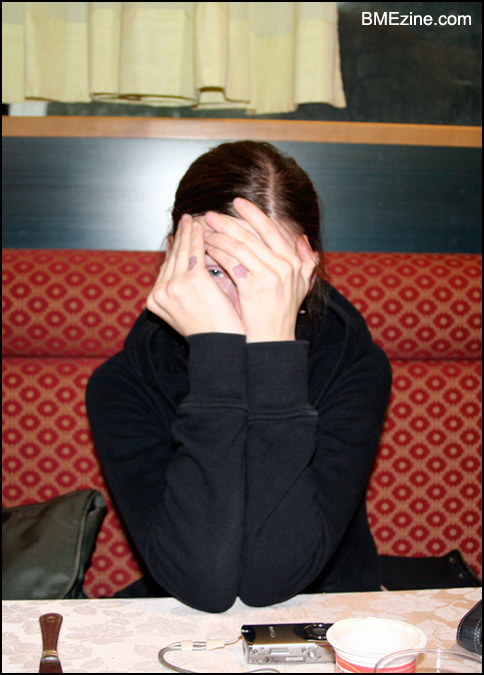
We were told that the convention center was to open at 10 a.m. and that all the vendors could get in earlier to set up their tables. Rachel brought a suitcase full of shirts to sell, and we were getting kicked out of the dining room anyway, so we headed down to set up shop. When we got there, there were already a bunch of people lined up to buy their passes and just hanging about.
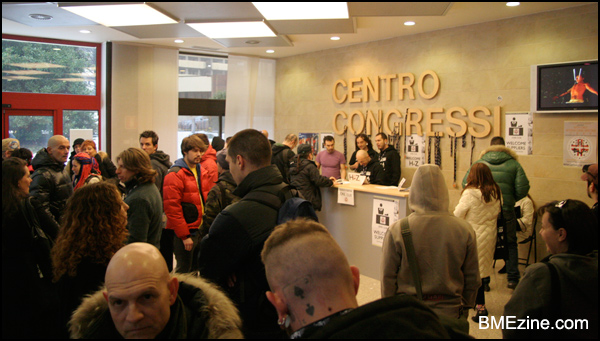
We dragged the suitcase downstairs and grabbed a table next to Rachel’s friends Jimmy and Jason. Jimmy, from Austin, makes some of the most amazing and intricate organic jewelry that I have ever seen. One of the media with which he works is Mammoth Tusk. Freaking Mammoth Tusk! You should check out his stuff. Some of it is sold through BME Shop.
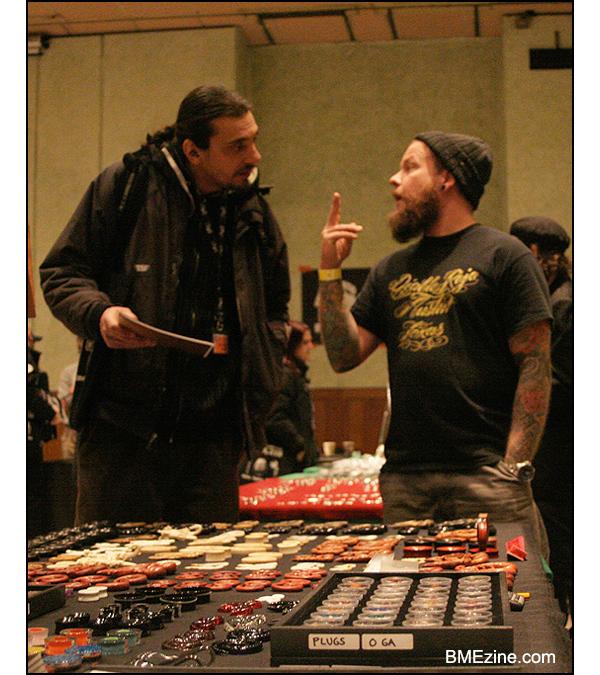
Jason makes glass jewelry in a style that I have never seen before. His company, Gorilla Glass from Mexico City, makes all their jewelry by hand. He was explaining some of the processes used to create the intricate patterns in some of the plugs. Pretty impressive!
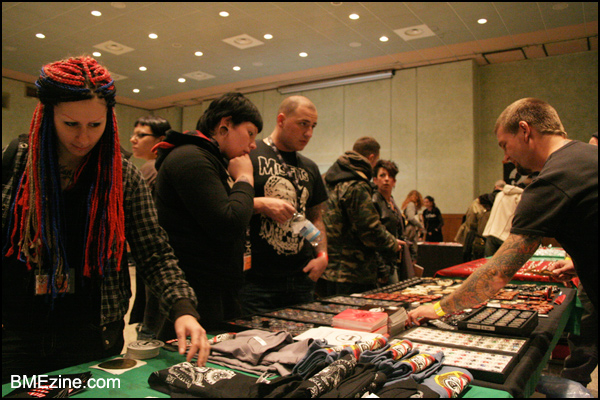
We placed all the shirts on the table and loaded it up with stickers. We were now ready for the masses!
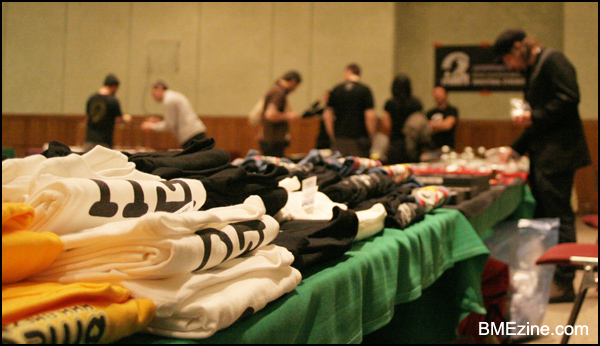
They opened the doors to the public and the people came in to do some quick buying of wares before the first class was to begin. There were two rooms of vendors and they both filled up quite nicely. This was the first time the convention opened itself up to people outside of Italy, so they had lot more people than their previous events.
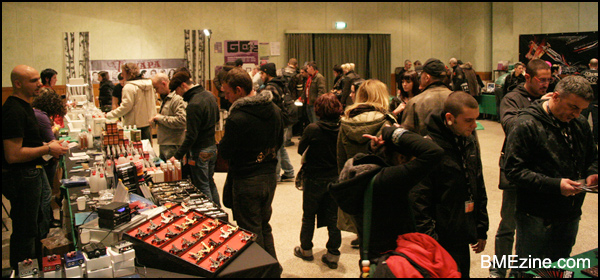
My Italian isn’t so hot … OK, I don’t speak a lick of Italian, so it made it a little difficult to communicate with everyone that was attending the convention. But me being the social butterfly that I am (still sober at this point, FYI), I tried to spark up some sort of conversation with everyone that was coming through. There were just so many cool and friendly people there that I wanted to at least get a “Hello” in. I mean, check out these two guys … how could you not want to say, “What’s up?”
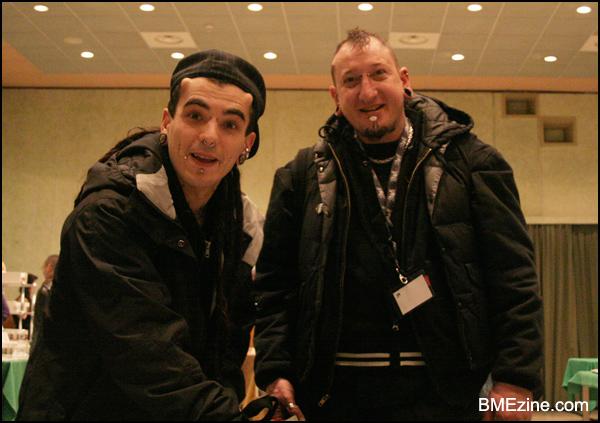
When the announcement for the classes was made, everyone left the vendor spots and filed into the lecture halls for the speeches and workshops that were to be given. Most of the talks were done in Italian with a couple in English. They provided headsets that would give translations into their respective languages. Being the techo-geek that I am, I thought this was one of the coolest parts!
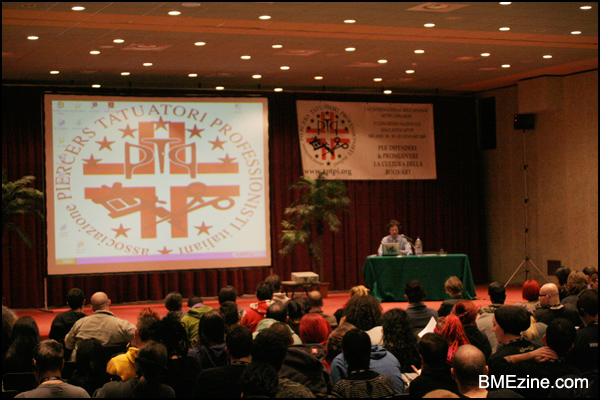
I’m not a piercer or a tattoo artist, so I didn’t follow along to the lectures. But I ran into a nice fellow from Germany that works for Wildcat.de named Stephan who seemed to have a similar interest in tech. I asked him why he had an external D-Link WiFi card on his MacBook Pro with a smirk on my face. When he returned the smirk with an equally menacing grin, I knew we’d get along. (Ten points to anyone that knows what he was doing!) [Ed. note: Nerrrrrrrrrrrds.]
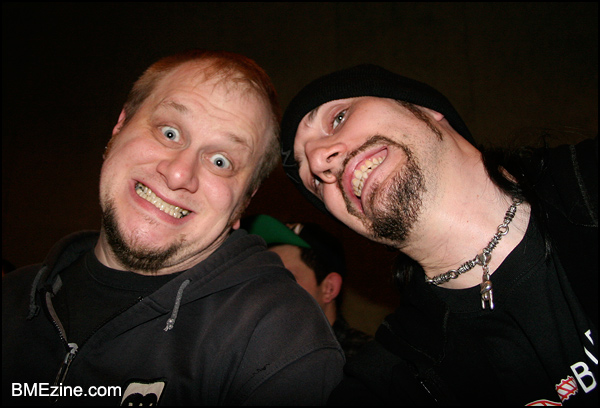
Around 2 p.m., I went back to the hotel lobby to get my room and put all my crap into it. Pretty painless. The most difficult part was looking at the bed on my way out of the room. Going on about 24 hours being awake, it was begging me to come lie on it. But no! I had to fight it. Must fight it! If I go to sleep now, I’ll never be in sync with everyone else, and the weekend will be ruined. Back to the convention!
When I got back downstairs I grabbed a Coke for the caffeine. (Coke in Italy doesn’t taste good … neither did the 7-Up, for that matter. Maybe it’s all soda over there … hmm.) We went back to the booth to relieve Rachel so she could go get her room all straightened out now. When I arrived, she was face down on a stack of shirts. I think someone probably got the “bonus” shirt with Rachel drool. (Just kidding … maybe.)
She grabbed her stuff and said she was going to go take a three-hour “nap.” Uh huh … next thing I know, it’s 8 p.m. and everything is over. I packed all the shirts away, and we all headed back to the lobby to meet up and go to dinner. I decided to wake up Rachel so she could come with us out to dinner. I asked the hotel clerk for her room number and she gave it to me (which I found odd). At this point, I’d been up about 30 hours and was kind of losing it. I got to the midget elevator (it’s like six feet high inside … I’m seven feet tall. Sucks for me), and there were two Asian girls in there that were immediately inquisitive about me. I chatted with them on the ride up and got off on the eighth floor. Crap … what was the room number? Ah yes … 813! I walked down the hall and knocked on the door loud enough to hopefully wake her up. Being the slap-happy moron that I am, I put on a stupid grin and song-and-dance stance when I heard the door opening. “Ta-Da! Whoops … my bad. Wrong room. Sorry!” Shit.
Back into the elevator, to the lobby, and I asked the lady again what the room number was that she just gave me. 815! So close.
Then she informed me that I can just call up from the phone right behind me. Why didn’t she say this the first time? I call. It rings. And rings. And rings. Nothing. Great, she’s sleeping the sleep of the dead. Back to the elevator!
Door opens, I go down the hallway to 815 and knock loudly. The door opens, and it’s her. Very groggy, and with “the look.” Not sure what it really means, but it’s kind of an, “I want to kill you, but with a fluffy bunny” look. Exhibit A:

Back in the lobby, we met up with everyone and then decided what to do for dinner. There were two parties: One was downstairs in the hotel restaurant, and the other was a group of people going out somewhere. After having to sit at a table by ourselves downstairs, we decided to meet up with everyone that was going out instead. We jumped in a taxi and were off! We had our own little room in the back, lots of food, lots of wine, and Jimmy threatening to butt-rape everyone there (in the ha-ha kinda way). Good times all around! Unfortunately I didn’t have my camera, but there were a lot of people that did, so I’m sure you’ll see some embarrassing photos floating around.
In the taxi ride back, I began to nod off. Almost there … must stay awake! It was around midnight and I was fading fast. Rachel took a different cab back and waited for me at the door to make sure I got back OK. Aww … how sweet. We agreed to meet up around 8 a.m. downstairs for the continental breakfast, said our good-nights and I headed up to my room.
I’m not sure if my pants even came off. I’m almost positive that I was asleep before I even hit the bed. Forty hours later and I’m out! Day one was over.
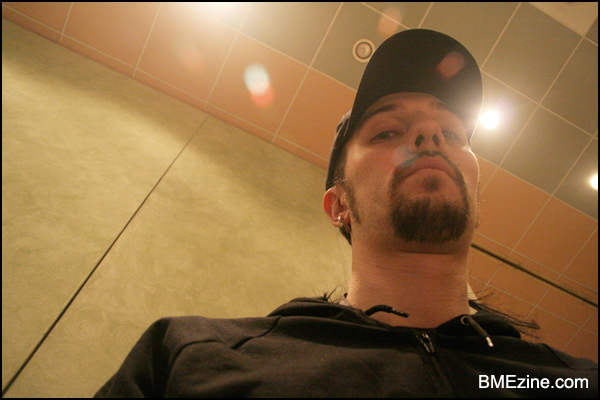
Day two began with the hotel maids. They just love to ignore the “Do Not Disturb” sign hanging on the door. The first time they knocked on the door (yeah, they came about three times) I woke up and opened the door thinking it was Rachel, telling me to get up. Surprise! It was two maids making gestures about how they want to come in and service the room while pointing at the sign! I just laughed. What else could I do? “No, no, no,” I protested, and then went back to sleep. The next couple times they came by I just shouted from the bed to go away.
I wound up finally getting up around 5:30 p.m. The sun was definitely gone. I got myself together and headed downstairs to catch the tail-end of the convention. When I got downstairs, I saw my new friends, Rachel and Stephan, hanging out and goofing around. Ahhh … my people.
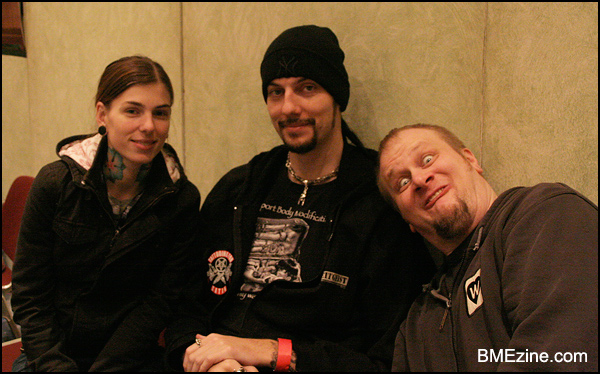
Turns out, Rachel had the same though as me this morning, “I’ll just stay asleep a little longer, [Adam/Rachel] is probably already down there running the show.” Haha! We hung out for about an hour and a half until the end of the convention. The next item on the agenda was a fancy dinner banquet in the hotel. The unwritten rule seemed to be, go change into your evening clothes and then meet in the lobby for drinks. Rachel, Stephan, and I seemed have skipped out on the first part of that and just went straight to the lounge. It filled up rather quickly and everyone was in a great mood. To me, this is what conventions are all about. It’s a large gathering of similar thinking people that would normally never meet otherwise having an awesome time trying to talk in all kinds of languages.
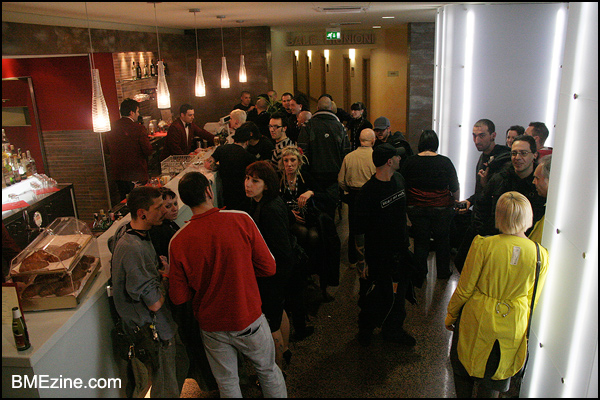
Rachel and I wanted to make sure that we didn’t get stuck alone at a table this time, so we headed in first and grabbed a table. Unless everyone secretly conspired against us, we had good a chance of having our friends join us. The room filled up rather quickly and was full of cheerful talk, laughter, and some occasional hollering across tables. Everyone was in good spirits and ready for dinner.
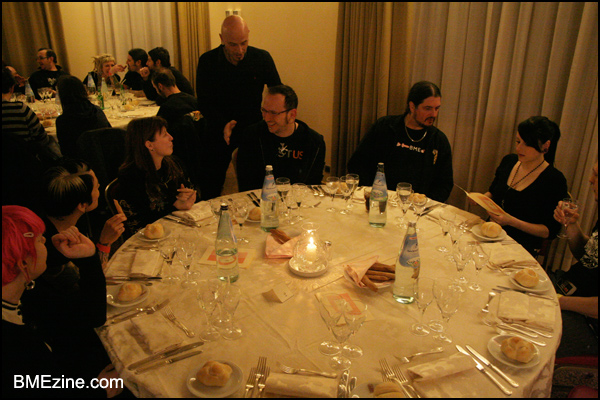
Our first course was a mushroom and asparagus pastry with a cream sauce. I think it lasted about 30 seconds in front of me; it was damn good. The next course was a risotto. Ours wasn’t cooked all the way, and our table turned into the Top Chef judging table. It wasn’t the most delicious thing in the world, but it was good and I was hungry. I also had a feeling that I would not like the main course because the only word on the menu I recognized in the main dish was eggplant … blech! Sure enough, eggplant was delivered. It did have these two giant tater-tot things that were pretty good, but that was all I ate of it. A couple from our table decided to head in early, so we all had the great idea to put our food by their spots so it looked like they didn’t eat the food. It was brilliant!
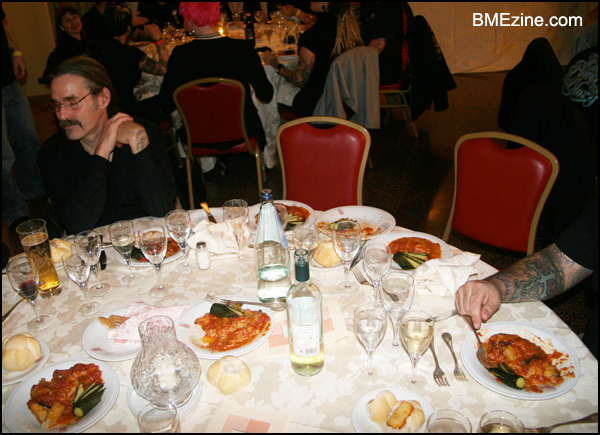
While we were waiting for dessert, I went over to another table to mingle with a couple from Oslo. I mean, how often do you get to hang out with girls from Norway? While we were chatting, a guy asked me what his shirt said. Yesterday, two guys at the table purchased a shirt from the BME booth with a pictogram that says, “I Screw BME Guys.” Turns out, the “screw” portion of it didn’t translate properly, and they weren’t too pleased that they had been walking around wearing a shirt that said they liked guys. We poked fun at each other for a while about it, and then one of the guys told me that he wanted one of the shirts that I was wearing. I told him that it was impossible because it was the only one: I made it myself for my site. It wasn’t even a BME shirt. But, being the awesome guy I am, I told him that I would trade him shirts, but it had to be right then. He accepted. So in the middle of the dining hall we traded shirts. I think the few glasses of Jagermeister and wine in me helped with this process. Here’s a photo of a happy guy in my shirt:
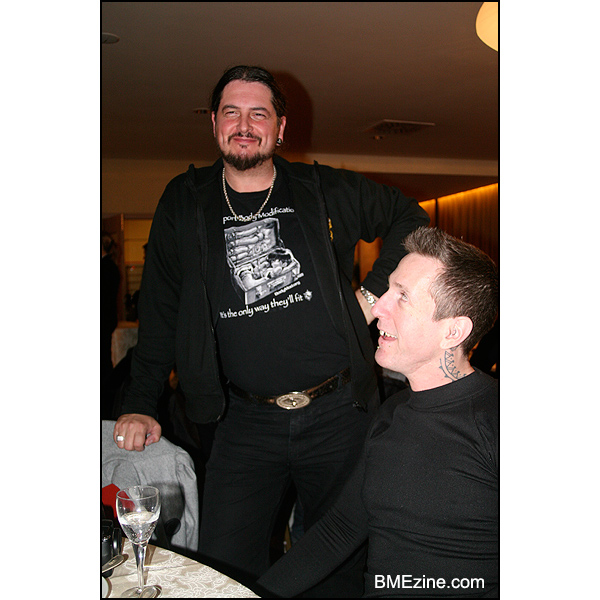
I spent the rest of the evening in his shirt proudly proclaiming that I screw BME guys … ha ha. Amazingly, girls seemed to have dug it. Or maybe, Jager makes you think that girls like you wearing shirts that say you’re gay. Either way, we all had a great time and great conversations.
The cake came out, and the cheers came from the crowd to Bruno, Brenno, and Beppe for hosting the convention. I’m pretty sure there was even a, “Hip, hip, hooray!” After the toast, we all filed back to the convention area for an evening of entertainment. The hall filled up with everyone eagerly awaiting the sexy burlesque show.
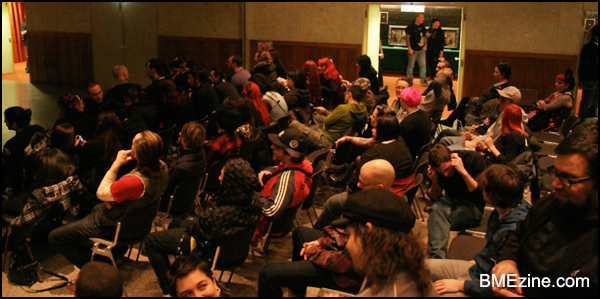
The chairs were about a hundred feet back from the stage, so I took it upon myself to grab a bottle of wine and my camera and go plop down in the front. That seemed to have started a trend. Soon everyone that didn’t have a seat came running up to the front for a closer view of the show. There were three performances, a 20-minute break, and then a few more to wrap it up. The final showing was my favorite. Great use of giant ostrich feather fans. I mean, add a nekkid girl and how could it not be awesome?
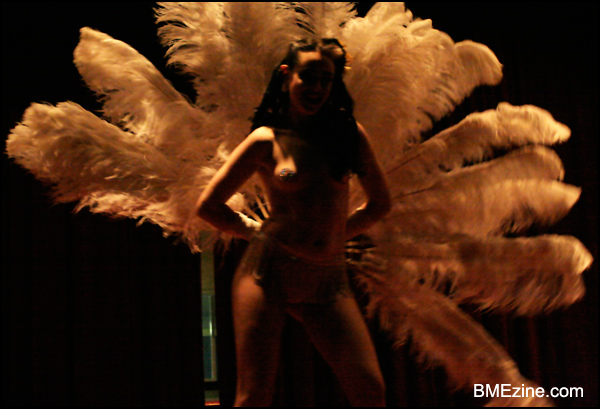
When the show ended, everyone parted ways and for the most part went back to their rooms. It was about midnight or so (maybe later … no clue really). Rachel wanted to crash out, so she went to bed. Stephan and I on the other hand wanted to find out where the party was. Mission one: walk up and down the hallways and listen for a party. After three floors, we found nothing! I couldn’t believe it. Mission two: Head to the lobby and see if there were a bunch of people hanging out there.
As soon as the elevator doors opened on the ground floor, there was a girl standing there. Stephan, with his German charm, asks, “What room are you in?” Ha ha! She told us to follow her to meet up with everyone else. Worked for me. We hit up a couple more rooms and picked up a couple others that wanted to hang out and then headed back down to the lobby. Sadly, there was no one there to disturb.
Now we were down to our last mission: Alcohol. The bars were closed, and there weren’t any stores around open to buy anything. Then, like an angel from Croatia, our friend Ana showed up with a bottle of Jager, some vodka, and wine. Hells yeah!

I’m not sure who was all there throughout the evening, but overall, we had a great time! I think we may have gone over the top on the crazy side at some point though. There was a point where a cool Croatian guy was showing me takedown moves with the flick of a wrist, and a Slovenian girl grabbed my camera and snapped a few photos.
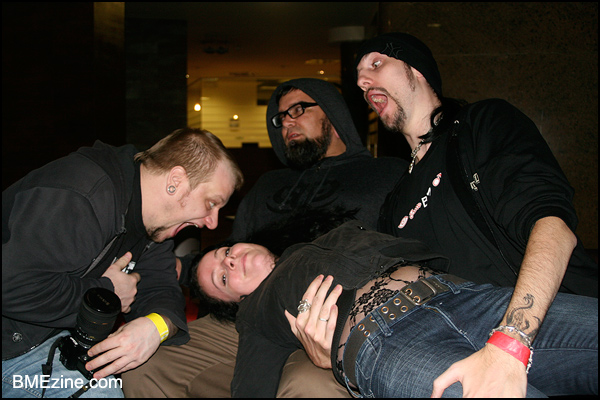
The end of the night is a bit foggy, but it was somewhere around four or five in the morning and all the alcohol was definitely gone. We all agreed that the night was over and exchanged our good-nights. Day two had come to an end.
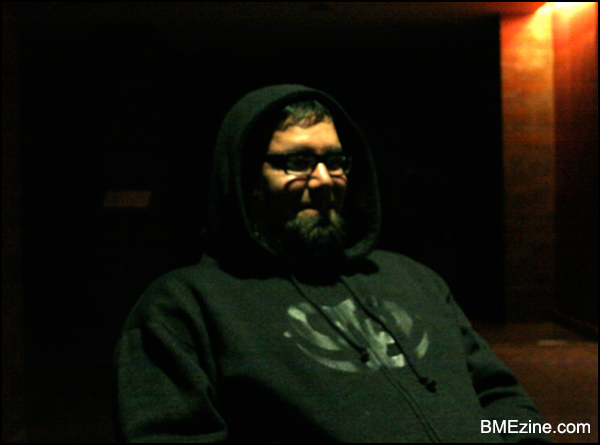
For the third day, I figured I’d get up early. I rolled out of bed around 1 p.m. and went down to the vendor booths. We spent most of the remainder of the conference goofing off and playing with the stickers. Stephan gave us a bunch of “No Piercing Guns” stickers, and Rachel took it upon herself for us to advertise how strongly we feel about it. There was a chair involved so that my head would be in the photo.
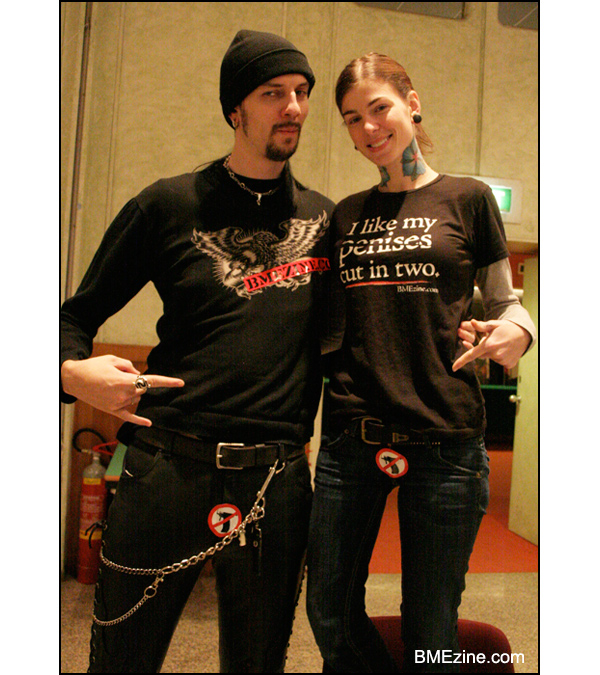
Towards the end of the conference, a lot of photo-taking was going on. We all met a lot of new people and had great times sharing the space with each other. I don’t think there was a single person that left the conference without a smile on their face. Everything was just too much fun!
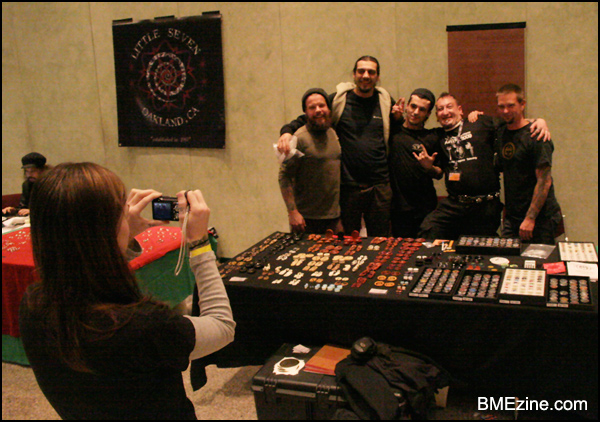
For our final dinner in Milan, Stephan took it upon himself to find a great (not merely “good”) restaurant. Again, with the taxi game of, “Who had the lowest fare?” we all made it to the place just in time before the kitchen closed. Unfortunately the menu was only in Italian, so ordering was a little difficult. Then came in our saviour, Christiano! He played interpreter for us all to the waiter. I accidentally ordered a lump of gelatinous cheese as an appetizer. It wasn’t the most delicious thing in the world, but it was kind of entertaining to eat. The main course for all the meat-eaters was a giant pan of steak and potatoes.
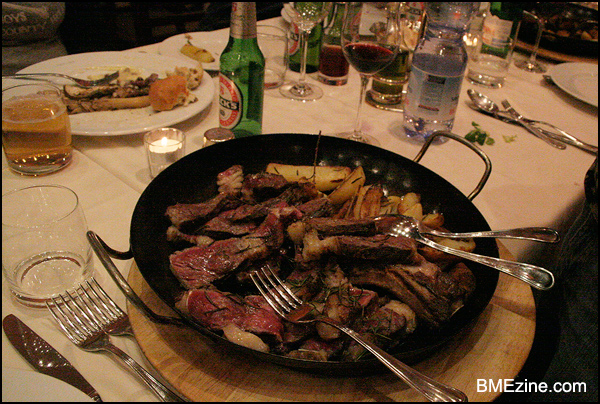
Rachel and I had to do a little convincing and schooling as to why we should order it medium-rare. Can you believe someone actually asked for it medium-well? Sheesh! It was cooked perfectly and had excellent layers of flavor. After the main course, a bunch of people ordered some desserts. Jason got a “special” dessert. We then went through a couple more bottles of wine and headed back to the hotel.
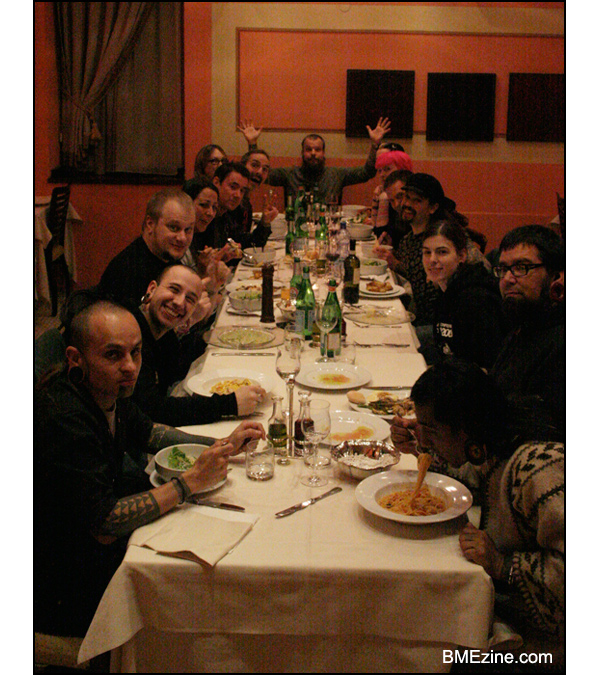
Back at the hotel, we wanted to continue the festivities, so we all piled into Rachel’s room with a few more bottles of wine and some heavily demanded trail mix. All I’m going to say here is, don’t light the filter! Ha ha! We all hung out until at least 3 a.m. or so, laughing and carrying on. Jason got us in trouble a couple times because he doesn’t like to be shushed. He just laughs too loudly! And … we kinda kept prodding him to keep him laughing.
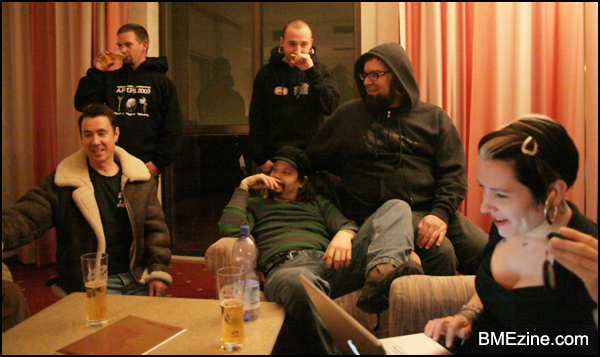
Rachel and I had to leave the hotel by 8 a.m., so we knew that we weren’t going to bed that night. Most people bailed around four in the morning to crash in their rooms. Our friends Didier and Christiano kept us company the whole night! They even came down to breakfast with us. Those are some true rockers. For anyone that knows me, staying up 30-plus hours at a time isn’t anything unusual at all, and apparently Rachel’s a big fan of insomnia and working insane hours too. Yay!
Close to 8 a.m., Rachel and I jumped in a cab and headed for the airport. We got through customs and security pretty easily. I guess not too many people were leaving Milan on a Wednesday that early in the morning. We even had time to grab a slice of pizza before getting on the plane.
Our flight back was just over nine hours (crap). I think Rachel passed out pretty much right after take off. I stayed awake just long enough for the free lunch and to watch Lakeview Terrace (which sucked). I then put on my headphones and passed out.
I was woken up by Rachel stepping on me trying to get over me to go to the bathroom. (She’s so mean!) We landed about 20 minutes later. I normally don’t sleep so well on airplanes, but I had no problem this time.
Rachel had to continue on to Austin, so I gave her a hug and said adios. I jumped in a cab and went home. Finally … three weeks later and I get to sleep in my own bed! I had an amazing time in Italy. I wish that I could have seen more of what the city had to offer, but time and weather just didn’t permit it. Maybe I’ll go back for the Milan Tattoo Convention in February. We’ll see!
I hope to meet more of you and build some awesome memories.
Take care everyone!
* * *
Please consider buying a membership to BME so we can continue bringing you articles like this one.



























